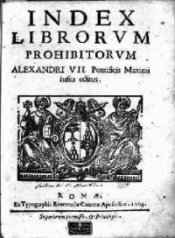|
Illuminations and Epiphanies
Banned Books
A Chronological Collection of
Banned Books
The 1800s
|
The Works of
Shakespeare. In 1818 Thomas Bowlder published an expurgated
version of Shakespeare’s works, The
Family Shakespeare, that removed "those words and expressions
that cannot with propriety be read aloud in a family," so as not to
"raise a blush to the cheeks of modesty.” While Bowlder’s
was the most famous expurgation of Shakespeare’s works, it is far from
the only one. Shakespeare’s plays have been revised—inevitable to
eliminate profanity or ribaldry—since the mid-1600s by an
assortment of “editors” including William D'Avenant, Francis Gentleman,
John Hows, and others, however formal banning of Shakespeare’s works
has been infrequent. One scene in Richard
III was temporarily banned in England as it infuriated Queen
Elizabeth. A short reference to a Scottish lord was excised from The Merchant of Venice, for a short
time. All references to Denmark were removed from Hamlet to mollify the Danish
Queen, Anne. And, performances of King
Lear were banned in the United Kingdom during the years of King
George III’s insanity. |
|
|
The
works of Heinrich Heine. Today, most Germans can recite all of
Heine’s most famous poem, Die Lorelei,
and many grow up believing that it was a traditional folksong with
no established author. That is because all of Heine’s works were
banned throughout Germany in 1835. Heine was a leader in the
Junges Deutschland (Young Germany) movement, an informal organization
of writers set on “liberating” Germans from established political,
religious, and philosophical views. The movement was seen as a
threat to the established order, and the writers’ works were
banned. Heine then left Germany for self-imposed exile in France,
where he continued to write. Heine’s works were again banned by
the Nazi’s in the early 1930s, however by then Die Lorelei had become so popular
that Hitler allowed it to appear in print, but only anonymously with no
mention of Heine. Following World War II, Heine’s works continued
to be banned by the East German communist regime.
|
|
|
Hunchback of Notre Dame and Les Miserables.
Immediately after its publication in 1834, Victor Hugo’s Hunchback of Notre Dame was placed
on the Catholic Church’s Index
Librorum Prohibitorum, not for any theological reason—although
the book does have some anti-clerical comments, but rather because the
Church censors found it, along with many other fictional works, to be
"sensual, libidinous or lascivious." Later, Hugo’s Les Miserables was also placed on
the Index, for similar reasons.
|
|
|
Madame Bovary. Gustave
Flaubert’s Madame Bovary, a
novel about a doctor’s wife who engages in a series of adulterous
affairs to escape the boredom of her provincial life, was almost
immediately attacked by public prosecutors as obscene after it was
first serialized in the Revue de
Paris in 1856. Flaubert and the book were tried and
acquitted in court during January and February of 1857. The novel
was released in book form in April of 1857, and quickly became a
bestseller.
|
|
|
Origin of Species. The Origin of Species is another title
that appears on almost every list of banned books without ever having
been banned. Although Charles Darwin did not publish On the Origin of Species by Means of
Natural Selection, or the Preservation of Favoured Races in the
Struggle for Life until 1859, he had actually developed his
theory of evolution based on natural selection nearly twenty years
before. Knowing that its release would be incredibly
controversial, Darwin spent the intevening years compiling supporting
evidence and developing his reputation as a first class biologist.
Although the expected firestorm occurred with the book's publication,
the closet thing to a call for its banning was from the editor of the Athenaeum who demanded Darwin be
tried "in the Divinity Hall, the College, the Lecture Room and the
Museum".
|
|
|
Andersen's Fairy Tales. In
1835 Tsarist Russia, under Nicholas I banned the sale of Andersen's
Fairy Tales lest the violent nature disturb impressionable
children. The ban remained in place until 1849. The stories
were again banned in Soviet Union beginning in the 1930s because they
glorified princes and princesses.
|
|
| |
1850-2 Nathaniel Hawthorne - The Scarlet
Letter |
|
|
1852 Harriet Beecher Stowe - Uncle
Tom's Cabin
|
|
|
1857 - Les
Fleurs Du Mal - BAUDELAIRE, CHARLES
|
|
|
1859 George
Eliot - Adam Bede
|
|
|
1864 - Droll
Stories BALZAC, HONORÉ de
|
|
|
Tom Sawyer and Huckleberry Finn.
Mark Twain's The Adventures of Tom
Sawyer and The
Adventures of Huckleberry Finn were both attacked soon after
their publication. The public libraries of Brooklyn New
York, Denver Colorado, and Concord Massachusetts all barred the books from the shelves of their
children's rooms as "bad examples of ingenious youths" When asked
by a librarian from Brooklyn College to respond to the attacks on his
books, Twain replied with typically sarcastic humor, "I am greatly
troubled by what you say. I wrote 'Tom Sawyer' and 'Huck Finn'
for adults exclusively, and it always distressed me when I find that
boys and girls have been allowed access to them. The mind that
becomes soiled in youth can never again be washed clean; I know this by
my own experience, and to this day I cherish an unappeasable bitterness
against the unfaithful guardians of my young life, who not only
permitted but compelled me to read an unexpurgated Bible through before
I was 15 years old."
|
|
|
1881-2 Walt Whitman
- Leaves of Grass
|
|
|
1887 - Jose Rizal - Noli
Me Tangere
|
|
|
1890-2
(started in 1881) - Henrik Ibsen - Ghosts |
|
|
1894 - The
Banditti of the Plains - A.S. Mercer
|
|
To the 1700s
To the 1900s
|
|
